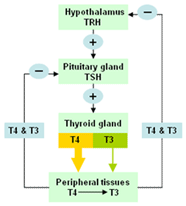First, many symptoms of thyroid imbalance are vague and most doctors spend only a few minutes talking with patients to sort out the cause of their complaint. Secondly, most conventional doctors use only one or two tests (T4 and TSH) to screen for problems.
Let me explain first explain how the thyroid gland and its hormones work so that you may better understand what I am saying.

Thyroid hormone production is regulated by a feedback loop between the hypothalamus, pituitary gland and the thyroid gland. Hypothalamic thyrotropin-releasing hormone (TRH) stimulates pituitary thyrotropin (TSH) synthesis and secretion. In turn, TSH stimulates production and release of T4 and T3 from the thyroid gland. When enough T4 is produced it signals to TRH and TSH that there is enough hormone in circulation and not to produce more.
About 90% of the hormone produced by our thyroid gland is T4, which is an inactive form of the hormone. After T4 is made, a small amount of it is converted into T3, which is the active form of thyroid hormone.
Therefore, if your doctor is only checking TSH and T4 then they are only checking the inactive form of thyroid hormone. Additionally, your TSH and T4 levels could be within normal range however you could have a problem converting T4 to T3 and therefore have symptoms of hypothyroidism.
Ideally your body would make this conversion from T4 to T3 properly and effectively however many people do not. There are several factors that contribute to making this conversion. Several nutrients including Iodine, vitamin D, vitamin A, tyrosine, B vitamins, selenium, zinc and iron are all critical to proper thyroid function and hormone conversion. Gluten sensitivity and mercury are also implicated in thyroid imbalance.
To complicate matters more, T3 also gets converted into either Free T3 (FT3) or Reverse T3 (RT3). It’s the Free T3 that really matters in all of this since it’s the only hormone that can attach to a receptor and cause your engine or metabolism to rev-up.
read more....